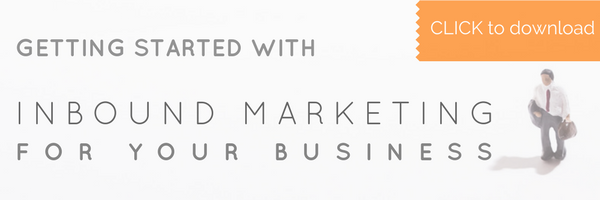HOW CAN ONE TELL IF MARKETING OBJECTIVES MAKE SENSE?
Simple... do they make more than cents?
Okay, maybe it's not a simple question. In fact, I know it's not. How? Because every time I get on the phone with a new prospect, we dive into these questions, and there are ALWAYS awkward silences that make us all squirm a bit as we try to sort through those that make sense.
So, let's not waste anymore time, and jump right into it.
Marketing objectives come in all shapes, sizes, and ideals.
But we shouldn't overlook them as we build our brand, because getting off on the right foot will be the difference between acheiving something that looks good on paper and something that actually grows your business.
Marketing Objective Examples that Miss
RELATED: 9 Examples of Marketing Objectives that Lead to Increased ROI
1. I want more visitors to the website
Why? What exactly is this going to do for you? Does more visitors automatically translate into more customers? What is that equation anyway?
2. I want more customers
Well, sure... we all want more customers. This isn't a bad goal, but it's not just one for marketing. It also takes sales, and product/service delivery.
3. Increased brand awareness
Okay, so now we're getting into the fuzziest part of marketing that tends to drive us formulaic practitioners of the marketing arts totally mad.
How do we measure brand awareness? More importantly, how do we turn that into money?
Don't get me wrong - building a brand is important. But it's so ridiculously difficult to quantify under these terms, and having a brand doesn't actually translate into sales.
Marketing Objectives Examples that Hit
Let's work backward, shall we? The goal is more customers. That's a sales goal. It's an operations goal. And, at the end of the day, it's part of the marketing goal as well, but we'll use these objectives as stepping stones to get there, not as the end-all be-all.
Let's say you have 5,000 website visits per month. Out of those 5,000 visits, you have a 1% conversion to leads rate - so, 50 leads per month. Out of that you have a 2% customer acquisition rate... so 1 new customer per month.
In this example, 5,000 visits = 1 customer. Okay, now let's figure out how to double the rate of customer acquisition to 2 per month by exploring every sensible avenue for marketing.
1. I want more qualified leads
Yes, we'll get to the part where we talk about more visitors to the website, but I don't want to start there, because it is by no means the only way to reach our objectives, and since we're really interested in succeeding, we're going to diversify our marketing investment... meaning, put our eggs in multiple baskets in case one doesn't work as well as the other.
Yes, there is a way to measure the quality of leads. Simply, how many are converting? Right now, we're seeing a 2% rate, but what if we were able to bump that up to 2.5% by increasing their quality before being passed off to sales?
Now, exploring this objective is going to have us deviate from our bigger-picture strategic goals, and focus on specific tactics, like email nurturing. Are you nurturing your leads with emails? I don't mean ad blasts, but informative, value-driven emails that lead your prospects further down the buyer's journey.
No? Why not give that a shot?
Yes? What are your open and click-through rates? How often are you being marked as spam or unsubscribed? Let's look there first, then peel it back to see how we can improve those numbers.
Better nurturing will improve the quality of your leads, and if you can bump that 2% up to 2.5%, then we've moved the needle to 1.25 customers per month without adding a single drop of traffic.
2. I want more leads
Technically speaking, if we double the traffic we'll double our leads, but what if instead, we focused on the traffic we currently have first to see if we can get more favorable lead conversion numbers? 1% isn't great... neither is 2, but we don't have a huge window (6 months), so let's settle at raising the bar to 1.5%. That's an increase of 50%, after all.
That means we'll be getting 75 leads per month instead of 50. It also means that we'll be getting 1.5 customers per month instead of 1 based on this number alone. Okay, so let's do some more math:
By increasing the visitors-to-lead conversion percentage from 1 to 1.5, we increase lead-flow by 25 per month up to 75. Then, if we increase the quality of the leads with nurturing to 2.5%, that puts customer acquisition up to 1.87 per month, and again, we haven't even TOUCHED traffic!
Okay, but HOW do we get there? Well, that's a great question, and one that I can answer directly, but having more quantifiable objectives is the key to getting off on the right foot. (schedule assessment - identify your goals)
You need to have a lead conversion path in place to qualify and capture traffic to start.
3. I want more relevant traffic
Yeah, you do! But now that we're raising the bar everywhere else, the journey that gets us from point A to point Z is no longer quite as daunting, is it?
Let's do the math, and work backwards from there:
5,000 visitors now equals 1.87 customers, and we want a minimum of 2 customers per month. There is a 6.67% gap that we need to fill or 333.33 visits.
Now, it should be noted that in order to increase conversions to leads and customers, you're going to want more relevant traffic, not just volume. That means pumping more cash into Adwords may not be our best bet, not when those channels typically have lower conversion rates than the others.
What is the best way to measure the quality of your traffic? Try your visitors-to-lead conversions.
What is the best way to drive quality traffic? Try SEO, blogging, and social media

Look, it's hard to let go of these wishy-washy goals. I get it. There was once a point in my life when I said that I blogged for more traffic and thought leadership (does that sound like you?), but we can't pay the bills with traffic or popularity. We have to come up with systems that monetize our efforts, and that's why I transitioned my firm from social media consulting to a turn-key inbound marketing agency.
Inbound addresses each stage of the buyer's journey, not just the top of funnel traffic, middle funnel leads, or bottom-funnel nurturing.
Nope, we hit EVERY. SINGLE. ONE... and then some.
Interested in an inbound marketing assessment? Click HERE.



